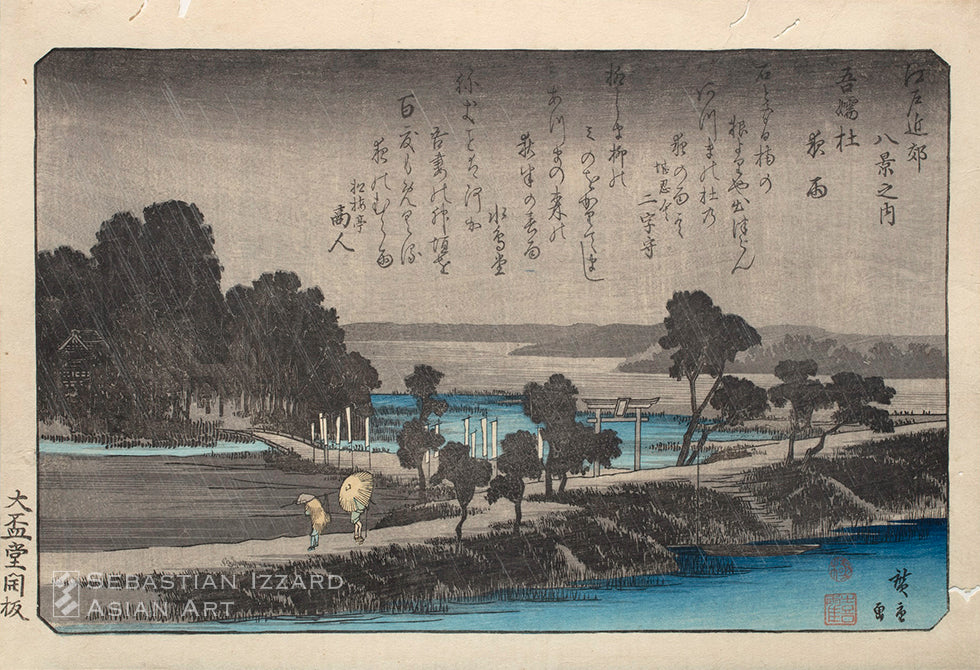Watch Video:
Sebastian Izzard Talks About Privately Commissioned Japanese Prints
March 2022 Exhibition
The spring exhibition at Sebastian Izzard LLC Asian Art will feature surimono, the privately commissioned counterparts to the commercial Japanese woodblock prints of the late eighteenth and early nineteenth centuries. Produced in small numbers for a mostly educated audience of literati, surimono were often more experimental in subject matter and treatment, and extravagant in printing technique, than commercial prints. The poetic texts which often appear on these prints were of equal importance to the illustrations, and because they were privately printed and distributed, surimono neither had to be approved by the censor nor do they bear publisher’s seals.
Unlike commercial publishing, cost was not a primary consideration in the production of surimono. Only the finest quality paper was employed. Skilled artisans cut highly refined and complex matrices of blocks which craftsmen worked with new and inventive procedures and materials. The recently developed color printing techniques included: wiped shading (bokashi); gauffrage, also known as embossed or blind printing (karazuri); stenciled ground mother-of pearl and mica powder (kirazuri); spray-printing (fukibokashi); burnishing (shomenzuri); and metallic pigments made from brass or tin, which gave the appearance of gold and silver. All were applied to give nuance to the prints and served to catch the eye and impart a luxurious, almost tactile quality to them. The shikishiban, or square paper shape, soon became the format of choice among the many ukiyo-e artists hired to design surimono.
By the turn of the eighteenth and nineteenth centuries surimono had evolved into two main forms: as an announcement or invitation to a special event; and as prints individually commissioned by poets or poetry groups to serve as a vehicle for illustrating their verses in celebration of the season or for some other chosen theme. The amateur poets who paid to have their poems included were often wealthy, and their patronage was a lucrative source of income for artists.
Surimono reached their apogee between the late Bunka era until the mid-Tempō period (1810–1835), a time of economic growth and lax fiscal policies. Two artistic groups dominated surimono production: the group of artists led by Katsushika Hokusai (1760‒1849) and his school, including Totoya Hokkei (1780‒1850) and Yashima Gakutei (1786‒1868), who specialized in still-life, landscape, and illustrations of classical Chinese and Japanese literature; and the artists led by Utagawa Toyokuni (1769‒1825)—and after his death in 1825 by Utagawa Kunisada (1786‒1865)—who became known for images of the theater and its performers. Fine examples by these artists as well as other renowned painters including Kitagawa Utamaro (1756‒1806) and Kubo Shunman (1757–1820) are featured.
Another highlight of the exhibition is a complete first edition set of Hiroshige’s “Eight Views of the Suburbs of Edo,” or Edo kinkō hakkei, long considered among his finest sets of prints. The series is thought to have been completed around 1837 to 1838 when Hiroshige, at age forty, had reached full maturity as an artist. Commissioned by the Taihaidō Poets Society, eight landscape subjects were selected, each of which featured a beauty spot in the far suburbs of Edo. The group then composed kyōka poems on the same theme; the best three or four were selected for inclusion on the landscapes themselves. Only first-edition sets include all the poems, as subsequent commercial editions of the prints omitted or replaced them, generally limiting them to one poem per image. Complete sets of the first edition are extremely rare, with only four examples extant.
A fully illustrated catalogue accompanies this exhibition.

Gifts of the Ebb Tide (Shiohi no tsuto)
Color woodblock-printed album with highlights in mica, metallic pigments, gauffrage and mother-of-pearl; orihon, paper covers indigo decorated in gold wash with pine-shoots and stylized clouds, with original title slip Shiohi no tsutoblack-on-buff paper
Mandarin Orange, Dried Persimmons, Smelts and Different Nuts; Food Used for the Celebration of the New Year
Color woodblock print with mica highlights: kokonotsugiriban surimono,
Signed: Shinsai sha
Issued by the Yomogawa (Four Directions Group)
Poems signed: Gurendō Nakakubo, Sōshūrō Kinrachi, and Yomo Utagaki Magao


(1757‒1820)
Bullfinches Perched on a Double Cherry Tree
Color woodblock print with elaborate blind printing: shikishiban surimono,
Artist’s seal: Shunman
Poem signed: Senshūan Hanamitsu
(1757‒1820)
A Pipe and Decorative Tobacco Pouch with Ojime Bead and Manju Netsuke
Color woodblock print with metallic pigments: shikishiban surimono,
Artist’s seal: Shunman Issued by the Yomogawa (Four Directions Group)
Poems signed: Senzaitei Tazu Tomotoshi, Shosadō Shunman, and Yomo Takisui Komehito


Ichikawa Danjūrō VII as Kamakura no Gongen Kagemasa from the Play Shibaraku (Wait Just a Minute!), with His Fortunate Bat
Color woodblock print: shikishiban surimono,
Signed: Jihinari ga san (Jihinari designed and inscribed)
Issued by Sakuragawa Jihinari
Provenance: Sidney Ward; Paul Walter; Horace and Gloria Becker
The Horse’s Farewell Gift (Uma no senbetsu)
Color woodblock print with metallic pigments and gauffrage details: shikishiban surimono,
Series: Everything Concerning Horses (Uma zukushi)
Signed: Fusenkyo Iitsu hitsu
Issued by theYomogawa (Four Directions Group)
Poems signed: Tōkeisha Seigyū (Shizuunshii); Kanshōsai Takara no Tsuchimochi; Shinratei Manzō


The Tachibana Clan: The “Common Gate” Sutra and Chrysanthemum-and-Water Armor (Tachibana: fumonbon kikusui yoroi)
Color woodblock print with metallic pigments: shikishiban surimono,
Series: The Four Clans (Shisei no uchi)
Signed: Fusenkyo Iitsu hitsu
Poem signed: Sōkaen Gokumaru
Creating Surimono for the New Year
Color woodblock print: shikishiban surimono,
Signed: Hokusai aratame Iitsu hitsu
Privately commissioned by the poet Nanzan of Hagi in Nagatō
Signed: Nagato Hagi Settei Nanzan; Kyōkadō
Provenance: Paul Walter; Horace and Gloria Becker


Urashima Tarō Sleeping in the Sunlight
Color woodblock print: shikishiban surimono,
Series: A Series of Five on Longevity and Joy (Kotobuki goban no uchi)
Artist’s seal: Yanagawa
Printer’s seal: Seikō Issued by the Tsurugawa-ren (Crane circle)
Poems signed: Asaka no Katsumi, and Mochizuki Kagenari
The Earth Type (Dōsei)
Color woodblock print with metallic pigments: shikishiban surimono,
A Set of Five (Goban tsuzuki)
Signed: Gokotei Sadakage with toshidama seal
Issued by the Shakuyakutei-shachū (Shakuyakutei Circle)
Poem signed: Rōgetsuan Umekage


(1780‒1850)
Refreshments for a Theater Outing
Color woodblock print with metallic pigments: shikishiban surimono
Signed: Ōju Hokkei hitsu
Poems signed: Rikujūsai Yukifumi and Kitsujuen Sanae
Provenance: Adolphe Stoclet; Byron Crawford
(1780‒1850)
A Trained Monkey Performing with Jingles and Gohei
Color woodblock print with bronze and silver metallic pigments: shikishiban surimono,
Signed: Hokkei
Artist’s seal: Hokkei
Provenance: Paul Walter; Horace and Gloria Becker


The Brotherhood of the Three Kingdoms: Guan Yu, Liu Bei, and Zhang Fei
Color woodblock print with extensive metallic pigments: shikishi ban surimono,
Signed: Gototei Kunisada ga
Issued by the poet Baigetsukan Senrei
(1786‒1868)
Asahina Saburō
Color woodblock print with extensive metallic pigments: shikishiban surimono,
Series: Three Battered Gates (Haitatsu sanban)
Signed: Gakutei Issued by the Katsushika-ren (Katsushika Circle)
Poems signed: Manyōtei Itchō, and Bunkyusha Kanimi


Ichikawa Danjūrō VII and Assistants Prepare for a Performance
Color woodblock print with metallic pigments and special printing techniques: shikishiban surimono,
Signed: Ōju Toyokuni ga
Issued by Sakuragawa Jihinari
Poems signed: Yanagi no Itomaru, Sakuragawa Omokage, and Sakuragawa Jihinari
Ichikawa Danjūrō VII as Endō Musha Morichika
Color woodblock print with silver and bronze metallic pigments: shikishiban surimono,
Signed: Ōju Kunisada ga
Poems signed: Ichikawa Sanshō (Danjūrō VII) and Goryūtei Tokushō

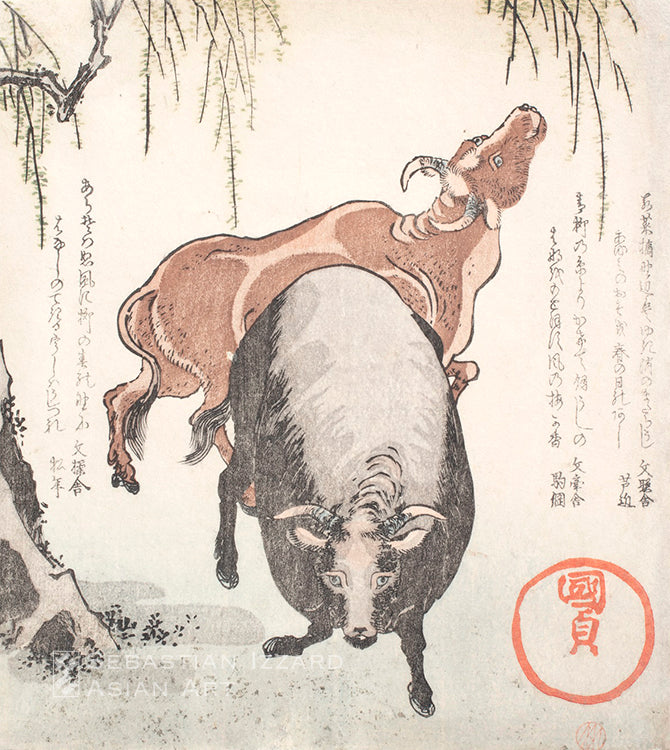
(1786‒1865)
Two Oxen Under a Willow Tree
Color woodblock print: shikishiban surimono,
8¼ x 7⅜ in. (21 x 18.7 cm); 1829
Artist’s seal: Kunisada
Poems signed: Bunshōsha Ashichika, Buntaisha Komatsuna, and Bunsōsha Matsutoshi
Provenance: Albert Maroni; James B. Austin; Horace and Gloria Becker
Boating on the Sumida River
Color woodblock print, with metallic pigments and blind printing: shikishiban surimono,
8 x 7¼ in. (20.3 x 18.4 cm); 1825
Signed: Ichiyūsai Kuniyoshi ga
Issued by the Hananari-shachū (Hananari Circle)
Poem signed: Ryūkaen; inscription signed: Ryūōtei Gijutsu
Provenance: Henri Vever; Edith Polster; Horace and Gloria Becker
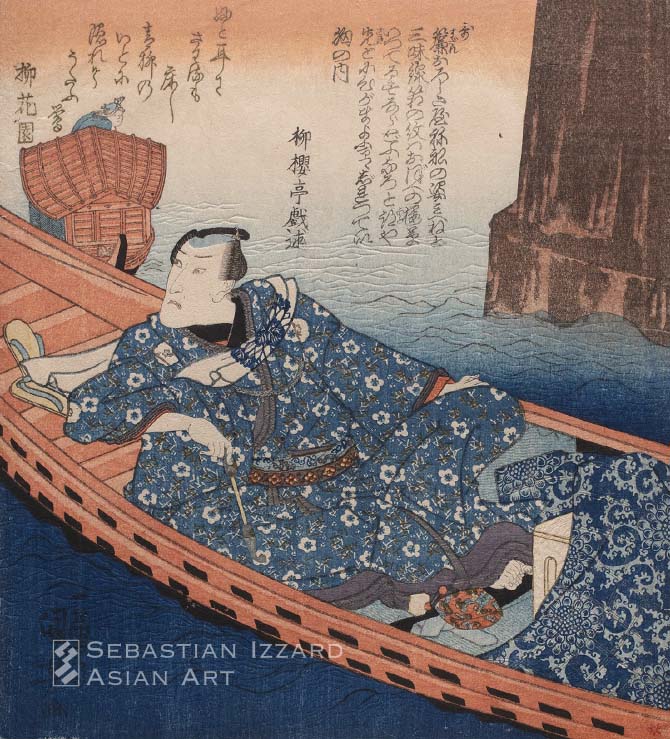
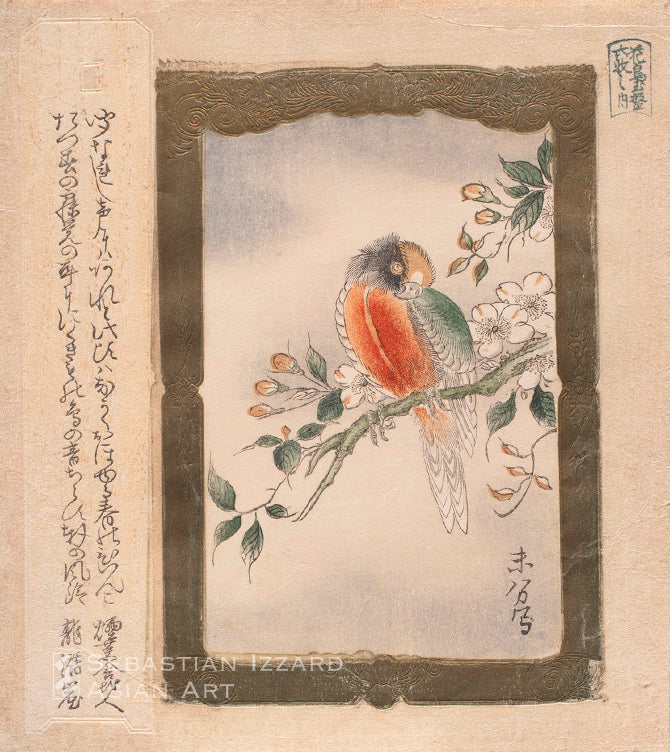
Picture of a Macaw
Color woodblock print:shikishiban surimono,
8¼ x 7¼ in. (20.8 x 18.5 cm); 1828
Series:Six Glass Pictures of Birds and Flowers (Kachō gyokuban rokumai no uchi) Signed:Mibun sha Poems signed:Enkōsha Kusabito, andRyūsenkutsu
(1780‒1850)
Kintoki Exorcising a Demon with Beans
Color woodblock print with metallic pigments: shikishiban surimono,
8 x 7 in. (20.2 x 17.8 cm); ca. 1830
Signed: Hokkei
Issued by the poet Tōkōen Gensen
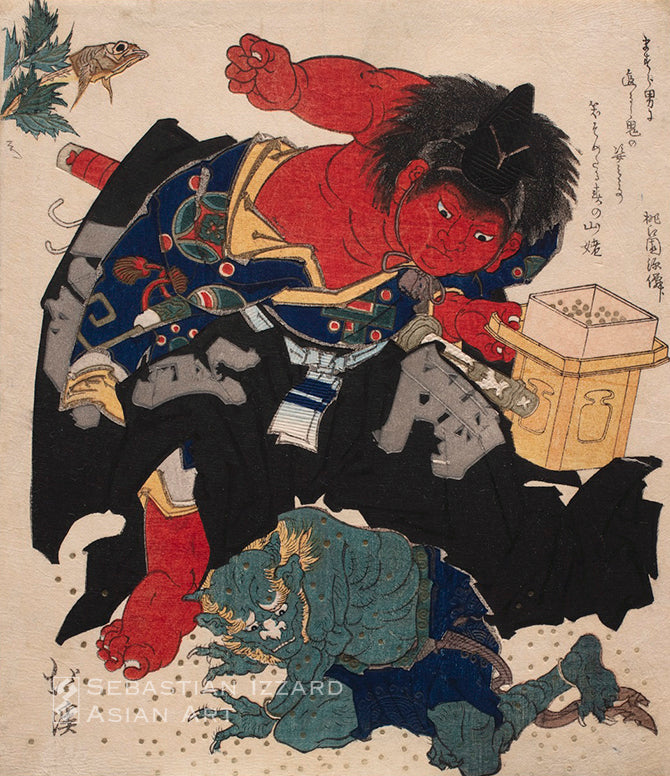
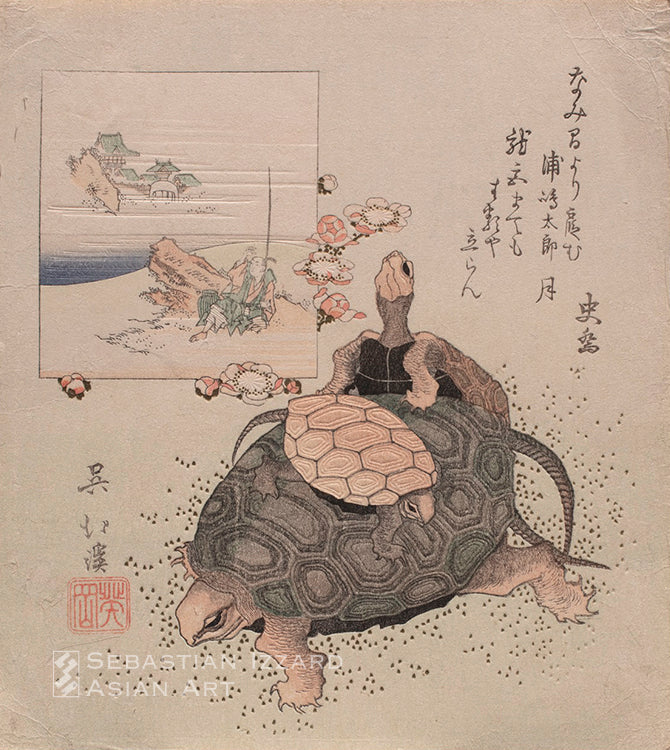
(1780‒1850)
Sea Turtles and Urashima Tarō
Color woodblock print: shikishiban surimono,
8⅜ x 7¼ in. (21.3 x 18.4 cm); ca. 1830
Signed: Go Hokkei
Artist’s seal: Aoigaoka
Poem signed: Shikyō (Kōjuken, also known as Arakitei Shikyō)
(1780‒1850)
Dragon in a Stormy Sky
Color woodblock print: shikishiban surimono,
8⅛ x 7¼ in. (20.6 x 18.4 cm); 1832
Signed: Hokkei
Artist’s seal: Hokkei
Poems signed: Shinsen’en Niwamori and Yohōtei Edanari
Provenance: Werner Schindler; Horace and Gloria Becker
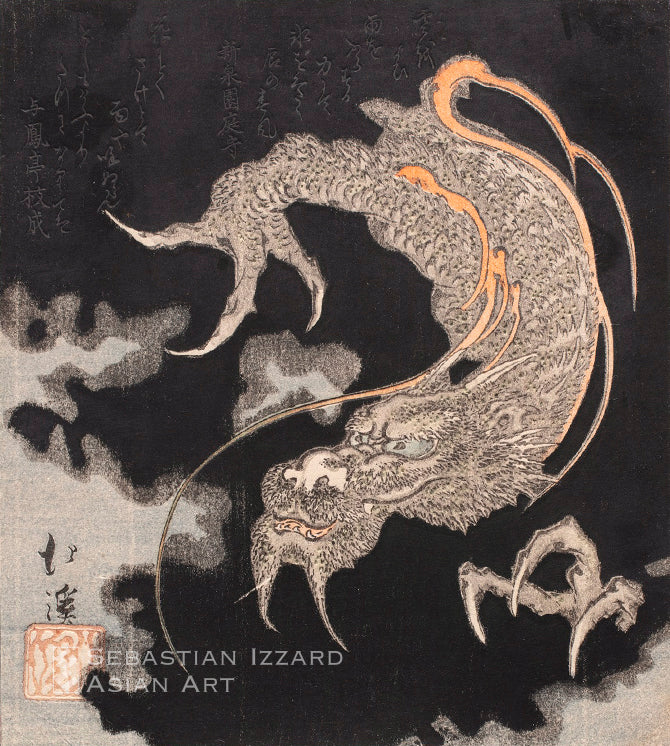
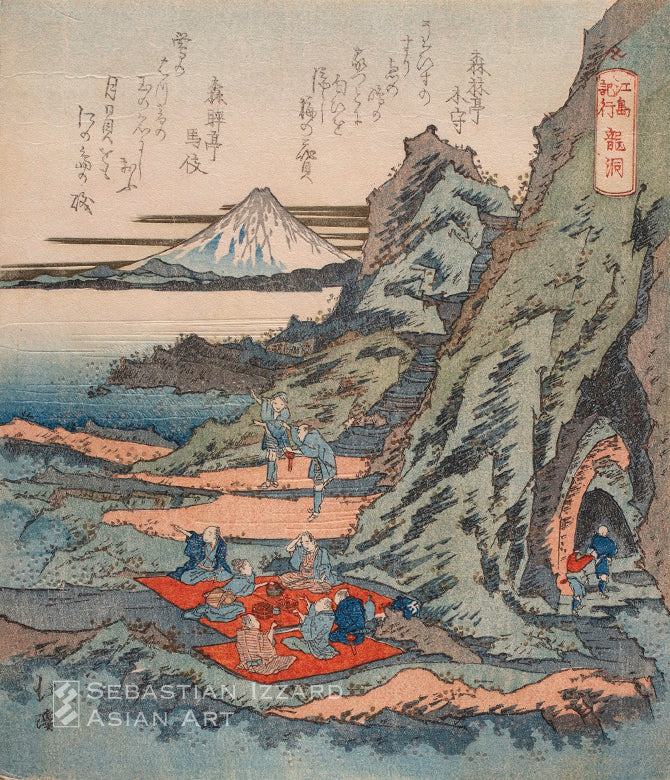
(1780‒1850)
The Dragon Caverns (Ryūdō)
Color woodblock print: shikishiban surimono,
8¼ x 7⅛ in. (21 x 18.1 cm); 1833
Series: An Account of a Journey to Enoshima: [A Series of Sixteen Prints] (Enoshima kikō [jūrokuban Tsuzuki])
Signed: Hokkei
Issued by the Manji-ren
Poems signed: Shinrintei Kinomori and Shinsuitei Baki
Provenance: Sidney Ward; Paul Walter; Horace and Gloria Becker
(1797–1858)
Eight Views of the Suburbs of Edo (Edo kinkō hakkei no uchi)
Set of eight color woodblock prints: ōban yoko-e,
each 10¼ x 14⅞ in. (26.0 x 37.8 cm); 1837/38
Each signed: Hiroshige ga
Censor’s seal: kiwame
Publisher’s seal: Kikaku[dō]
Commissioner: Taihaidō kaihan
